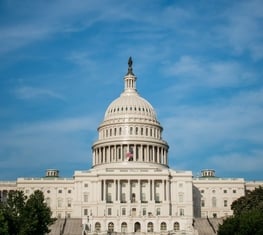By Eleanor Revelle (LWVIL and LWVUS Climate Change Task Force Member)
Facing the growing evidence that burning fossil fuels is contributing significantly to global climate change, policymakers are evaluating strategies for reducing U.S. greenhouse gas emissions. They have two general approaches to consider.
Cap-and-TradeWith a cap-and-trade system, policymakers set a limit on the quantity of a pollutant (e.g., CO2) that can be emitted in a given period. The total emissions allowed under this cap are divided into permits representing the right to emit a given amount (e.g., one ton of CO2). The permits are then allocated to the sources covered by the program (e.g., power plants). At the end of the compliance period, each source must report all emissions and surrender an equivalent number of permits.
Since the number of permits is limited, they have financial value. Companies able to reduce their emissions at low cost can sell the permits they don't need to companies for whom the cost of reducing emissions is high. Each company has the flexibility to choose how to meet its emissions target, but market incentives encourage them to develop new, cleaner technologies. Over time, the cap is lowered to achieve more aggressive emissions-reduction goals.
Carbon TaxA carbon tax is imposed on fossil fuel suppliers at a rate that reflects the amount of carbon that will be emitted when the fuel is combusted. The tax is included in the price of the coal, oil, and natural gas supplied to wholesale users and ultimately is passed on to consumers in the price of electricity,gasoline and other energy-intensive products. By raising the price of carbon-based energy, the tax creates incentives to reduce energy use, stimulates demand for more energy-efficient products, and promotes a shift to cleaner fuels and renewable energy.
Emissions Certainty
The strength of the cap-and-trade approach is that it sets firm limits on emissions. The cap is set at a level designed to achieve a desired environmental outcome (e.g., a reduction of CO2 emissions to 80 percent of 1990 levels by 2050).
A carbon tax allows the quantity of emissions to fluctuate as the demand for energy rises or falls. Allowing emissions to vary from year to year gives firms the flexibility to abate less and pay more in taxes when abatement costs are unusually high (and vice-versa when abatement costs are low). In order to achieve climatic goals, the tax rate can be adjusted over time to attain greater emissions reductions.
Price Predictability
The advantage of a carbon tax is that it fixes the price of carbon emissions. It creates a permanent incentive to reduce emissions, thereby encouraging investment in alternative fuels and energy-efficient technologies that have high up-front costs.
Under a cap-and-trade system, the price of emissions permits may vary considerably from year to year. An especially cold winter, for example, could increase the demand for energy and cause a spike in the price of permits. This volatility could weaken incentives to invest in cleaner technologies.
For illustrative purposes, this paper focuses on a cap-and-trade system for carbon dioxide (CO2).
To address volatility, most cap-and-trade proposals include cost-control mechanisms.
- Safety valve—establishes a ceiling on the price of permits. If the price reaches this level, the government can sell additional permits at this price to the capped entities.
- Circuit breaker—freezes a gradually declining emissions cap if the permit price rises above a predetermined level.
- Banking—allows companies to save unused allowances for future years.
- Borrowing—allows companies to borrow permits from future years and pay them back, with interest, later.
- Offsets—allow companies to cover some of their emissions by purchasing credits created by carbon mitigation projects (e.g., tree planting) from sources outside the cap-and-trade system.
These mechanisms (with the exception of banking) could delay emissions reductions and undermine the integrity of the cap.
Environmental Effectiveness
The impact of a cap-and-trade system depends on a number of factors. How stringent is the emissions target? How will baseline emissions be measured and a corresponding and appropriate number of emissions permits be determined and distributed? Will the cap be applied economy-wide or only to certain sectors? Does it include cost-control measures that are likely to break the emissions cap?
The impact of a carbon tax depends in large part on whether the tax rate is set high enough to create real market incentives to develop and adopt climate-friendly technologies. Although a carbon tax does not establish a firm limit on emissions, it applies economy-wide and provides a constant incentive for companies to make carbon-saving investments. The tax rate can be increased over time to provide stronger incentives to reduce emissions.
Equity
Under many cap-and-trade proposals, a substantial portion of the emissions permits are to be distributed free to the capped entities. Research indicates that only a modest portion of the permit value is needed to offset the costs of the cap, but the full amount is passed along in increased prices to consumers. This would disproportionately affect lower-income households because they tend to spend a larger fraction of their income than do higher-income households and because energy products make up a bigger share of their spending.
A carbon tax directly raises substantial revenues. These could be used in part to fund "progressive" tax-shifting policies that would reduce the burden of higher energy costs on lower-income groups.
Simplicity and Transparency
A cap-and-trade system requires new institutions (e.g., a system to allocate permits, markets where firms can buy and sell permits, a means of monitoring emissions and trades). Auctioning permits rather than distributing them free could help promote simplicity and transparency.
A carbon tax can be levied and collected via existing institutions with experience in enforcing compliance. It is simpler and less expensive to administer and enforce than a cap-and-trade system. Its underlying premise—the price of energy should include the environmental costs associated with its production—is transparent and readily understood.
Produced by the LWVUS Climate Change Task Force
© 2008 by the League of Women Voters of the United States
Sign Up For Email
Keep up with the League. Receive emails to your inbox!
Donate to support our work
to empower voters and defend democracy.




